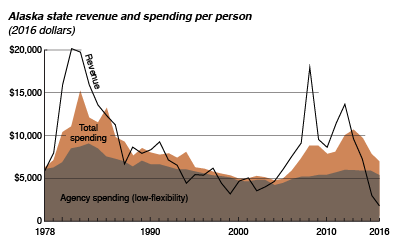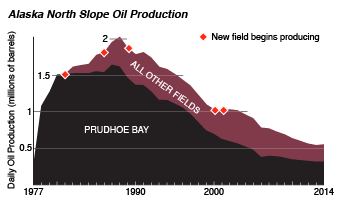Why Oil Won't Save Us – The Need for New Revenue Sources
Last modified: 12th August 2019
Executive summary
Since the discovery of Prudhoe Bay, oil revenue has funded most of state government, but this cannot continue indefinitely into the future. Since the 1980s, oil production has been steadily falling, while the state population has grown. Tax schemes cannot make up the difference but complicated rules open the tax system up to additional risk and gaming potential. The state has attempted to reverse this trend by heavily subsidizing the oil industry with cash-back tax credits. Regardless of subsidies, finding another Prudhoe Bay is extremely unlikely, both geologically and economically. Even large new discoveries may not help the state treasury if large incentives are required to bring them on line. Despite our heavy dependence on oil money, past department of revenue predictions have shown us that we have no ability to accurately forecast future oil revenue, so complicated arrangements that are partly based on particular production scenarios are extremely risky. The state government needs to shift to other revenue sources.

Why are we broke?
- Basic government services costs at least $3.7 billion/year at our current population.
- This number is based on the lowest inflation-adjusted state budgets from 1978 to the present, around $5000 dollars/person.
- Health care and retirement costs and obligations have increased, making any realistic budget higher.
- The budget for fiscal year 2016 was $5.2 billion, and the budget enacted for 2017 is $4.4 billion.
Our oil is not worth enough to fund that -- regardless of the tax plan.
- In fiscal year 2016, the oil produced on the North Slope had a wellhead value of around $6.2 billion.
- Between royalties and property taxes (other taxes were negative) the state got 18% of that - around 10% for the general fund, and 8% for the permanent fund, giving us $600 million to spend on government services.
- Historically, the state has gotten about a third of the wellhead value, but that would still be only $2 billion.
- To fund the 2017 budget on 2016 oil revenue would have required a 70% tax rate.
- That would leave the oil companties with nowhere near enough to cover costs. Their recorded expenses were already higher than wellhead value ($6.6 billion recorded expenses, $5.1 billion of which were deducted in taxes).

Price spikes can’t make up for the loss in production
- Oil tax revenue is exquisitely sensitive to oil price. Jumps in oil price have saved us in each past budget crisis. Even if prices return to recent highs, they might not be high enough.
- North Slope oil production is continually declining. Our population has risen substantially. In 1988, Alaska produced over 1300 barrels of oil per person, per year. In 2016, it was around 220 barrels per person.
- To fund the government on oil into the future, we need oil prices to rise quickly, stay high, and continue rising steadily into the indefinite future at a rate that counters the decline in production.
- Almost certainly, this will not happen. The state’s official forecast has oil prices slowly rising, reaching $88/bbl in ten years - not even close to the level we’d need to fund the budget on oil taxes.
- Even this forecast is more optimistic than many (such as OPEC’s) and almost certainly wrong. Oil prices are anything but steady, and have never matched the state forecasts. We are incredibly dependent on oil prices, and awful at predicting them.
Increased production won’t help if we have to pay for it
- Oil companies claim the large credits that are part of the current tax scheme have led to more development, which will eventually pay off for the state in increased tax revenue.
- Even if incentives do increase production (which is far from certain), they are unlikely to make money for the state. Incentives are not an investment.
- Current credit structure means the state pays 35% of costs for new developments. (past credit structure was more generous)
- New developments cost many billions of dollars. It takes a huge amount of oil, or very high prices, for the state to make that money back in taxes.
- An example: Let’s take the biggest new discovery of recent years - Caelus Energy’s Smith Bay discovery in 2016. According to the oil company, this will cost $8-10 billion to develop, and could produce up to 200,000 barrels per day. At a $65 per barrel oil price, it would take 8 years of that high level of production for the state to break even on its $3 billion (35% of the cost) investment. It would take much more than that for the state to actually make money for the general fund.
- If the state has $3 billion to invest, it would be far better to put that in the stock market.
- Reality may well turn out to be less rosy than oil company press releases. The state has sought to promote new oil development for decades, while production has steadily declined.
Other industries can’t fill the gap unless we add an income or sales tax
- We have no broad-based taxes (income or sales) on the majority of our population, and low taxes on other industries.
- As a result, any new jobs in non-oil industries cost the state more than they bring in in taxes, due to the increased need for schools, health care, and other services.
- One economist estimated that each new job costs the state an average of $1000. Since that analysis (in 1999), we have not added any significant taxes on non-oil industries or the population as a whole.
- With oil as the major revenue source and other industries as revenue sinks, the state is perversely incentivized to discourage non-oil businesses.
- An income or sales tax is the only way to reverse this.
Created: Jan. 19, 2018